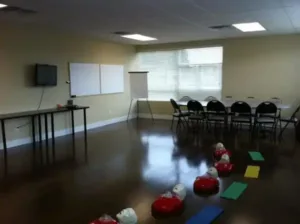Basic Life Support is the guiding principle followed in performing cardiopulmonary resuscitation (CPR). The concept of BLS was created by the American Heart Association – the AHA – in order to provide an easy-to-remember, step-by-step guideline when rescuing victims who have fallen unconscious because of cardiac arrest. The steps are called the “chain-of-survival” and refer to:
- Recognition of cardiac arrest (once a victim falls unconscious)
- Immediate CPR
- Rapid AED (automated external defibrillation)
- Post cardiac arrest care
Importance of BLS training

The occurrence of cardiovascular emergencies is very common in society today, with cardiovascular diseases at the top of WHO’s list of morbidities and mortalities in almost every country around the world. CPR training does not only teach students how to perform compressions and use AEDs, the lessons also teach students how to spread awareness on CV diseases and how to prevent them and their complications.
Automated external defibrillation (AED)
All Basic Life Support (BLS) programs teach students how to use automated external defibrillators (AEDs). AEDs are not only found in hospitals but also in basic rescue situations, especially in the presence of emergency medical services (EMS). Rescuers should have basic knowledge on how to use a defibrillator if one is available during an emergency situation.
BLS and the General Public

The BLS program has two kinds of CPR classes available to trainees. The first is for laymen, which teaches basic CPR and AED. The lessons are focused on providing assistance to adults and infants who have suffered cardiac arrest and choking. These topics are tailored towards the general public, instead of a target student audience.
Basic CPR and AED training runs for approximately 4 hours, including classroom lessons and skills training in high-end laboratories. In order to pass this program, students are required to pass the skills test and a written exam before they are awarded a certificate card. The card is valid throughout the country for two years.
BLS and Healthcare Providers
BLS for healthcare professionals are also available. The lessons for these classes are tailored specifically towards those working in a health care environment – such as nurses, nursing aids, sonographers, and other similar professions. Once of the highlights in BLS for healthcare providers is performing CPR on a victim with an advanced airway (e.g. an endotracheal tube). The situations that are simulated in the program are focused on emergencies that happen in hospitals, clinics, and other health care settings.
This program is longer than the first, taking 4-4 and a half hours to complete. The program also involves classrooms lessons, skills training, skills tests, and written exams. To pass, a student needs to pass both the skills test and the written exam as well.
Training set-up
The ideal setting for training is one instructor to six students. The latest training equipment are used in all classes, primarily up-to-date training mannequins and AED trainers. Students are all given student training manuals for the duration of the training period.
Trainees with completion cards for BLS for health care providers can opt for renewal courses as long as they sign up with their cards still valid. The renewal course for Basic Life Support (BLS) for health care providers is 4 hours long.
